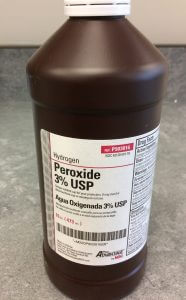It’s inevitable that pets will get into things they shouldn’t. At some point during ownership, you may need to know how and when to induce vomiting. Here are a few guidelines to follow, though we always recommend consulting with a veterinary professional.
There are some instances when you absolutely should not induce vomiting. These include, but are not limited to, the following:

- Cats- Cats should be seen by a veterinary professional to safely induce vomiting.
- Corrosive products were ingested (bleach, drain cleaner, etc.)
- Sharp Objects (fish hooks, chicken bones, needles, etc.)
- Hydrocarbon ingestion (gasoline, kerosene, brake fluid)
- Patient is already showing symptoms of toxicity.
- Patient is already vomiting.
- Unable to adequately protect the airway (megaesophagus, laryngeal paralysis, sedation, etc.)
- Severe brachycephalic dogs (Pugs, Bulldogs, etc.)
Inducing vomiting is recommended for ingestion of:
- Rat poison
- Chocolate
- Socks, undergarments, other cloth items
- Garbage
- Toys
- Rich, fatty foods (frying oil, bacon grease, etc)
- Compost
- Excess of almost anything

How to induce vomiting in dogs:
- Give 1 teaspoon of 3% hydrogen peroxide orally for every 20 pounds of body weight.
- Walk pet outside for 10 minutes. Stay with the dog so they don’t re-ingest the vomit.
- If no vomiting, repeat hydrogen peroxide up to 4 times until vomiting is achieved.
- Whether the pet vomits or not, consult a veterinary professional.
- Always monitor appetite, energy level, and bowel movements after inducing vomiting.
Note: The hydrogen peroxide method may not work if it is not the right strength, is expired, or is flat (has been open too long and doesn’t bubble). Try to keep a fresh, unopened bottle of 3% hydrogen peroxide on hand, and rotate it out with a new bottle frequently.
Bemidji Veterinary Hospital’s trained staff is available for emergencies 24/7. One of our veterinary technicians answers the phone after hours. She can answer your questions and help you decide what care your pet may need. If necessary, she will call in the Veterinarian on-call for emergencies. For small animal emergencies, call us at 218-751-2753.
What's Next
Call us or schedule an appointment online.
Meet with a doctor for an initial exam.
Put a plan together for your pet.


